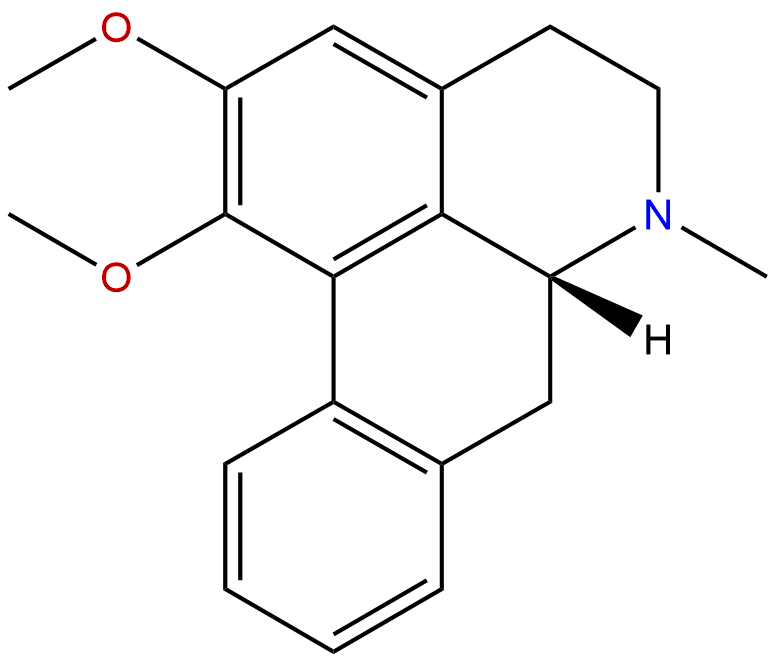
NuciferineCAS No.:475-83-2
|
||||||||||
 |
|
|
||||||||

| Catalogue No.: | BP1014 |
| Formula: | C19H21NO2 |
| Mol Weight: | 295.382 |
Product name: Nuciferine
Synonym name: Sanjoinine E
Catalogue No.: BP1014
Cas No.: 475-83-2
Formula: C19H21NO2
Mol Weight: 295.382
Botanical Source: Nelumbinis folium
Physical Description:
Type of Compound: Alkaloids
Purity: 95%~99%
Analysis Method: HPLC-DAD or/and HPLC-ELSD
Identification Method: Mass, NMR
Packing: Brown vial or HDPE plastic bottle
Storage: Store in a well closed container, protected from air and light. Put into refrigerate or freeze for long term storage.
Whenever possible, you should prepare and use solutions on the same day. However, if you need to make up stock solutions in advance, we recommend that you store the solution as aliquots in tightly sealed vials at -20℃. Generally, these will be useable for up to two weeks.
The product could be supplied from milligrams to grams
Inquire for bulk scale.
Description:
Nuciferine possesses anti-diabetic, anti-obesity, anti-hyperlipidemia, anti-hypotensive, anti-arrhythmic, vasorelaxant, and insulin secretagogue activities. Nuciferine may be potential for the prevention and treatment of hyperuricemia with kidney inflammation. It inhibited tumor-promoting effect of nicotine involving Wnt/β-catenin signaling in non-small cell lung cancer.
References:
Br J Pharmacol. 2014 Nov 19.
Nuciferine relaxes rat mesenteric arteries through endothelium-dependent and -independent mechanisms.
Nuciferine, a constituent of lotus leaf, is an aromatic ring-containing alkaloid, with antioxidative properties. We hypothesize Nuciferine might affect vascular reactivity. This study aimed at determining the effects of Nuciferine on vasomotor tone and the underlying mechanism.
METHODS AND RESULTS:
Nuciferine-induced relaxations in rings of rat main mesenteric arteries were measured by wire myographs. Endothelial NOS (eNOS) was determined by immunoblotting. Intracellular NO production in HUVECs and Ca2+ level in both HUVECs and vascular smooth muscle cells (VSMCs) from rat mesenteric arteries were assessed by fluorescence imaging. Nuciferine induced relaxations in arterial segments pre-contracted by KCl or phenylephrine. Nuciferine-elicited arterial relaxations were reduced by removal of endothelium or by pretreatment with the eNOS inhibitor L-NAME or the NO-sensitive guanylyl cyclase inhibitor ODQ. In HUVECs, the phosphorylation of eNOS at Ser1177 and increase in cytosolic NO level induced by Nuciferine were mediated by extracellular Ca2+ influx. Under endothelium-free conditions, Nuciferine attenuated CaCl2 -induced contraction in Ca2+ -free depolarizing medium. In the absence of extracellular calcium, Nuciferine relieved the vasoconstriction induced by phenylephrine and the addition of CaCl2 . Nuciferine also suppressed Ca2+ influx in Ca2+ -free K+ -containing solution in VSMCs.
CONCLUSIONS:
Nuciferine has a vasorelaxant effect via both endothelium-dependent and -independent mechanisms. These results suggest that Nuciferine may have a therapeutic effect on vascular diseases associated with aberrant vasoconstriction.
PLoS One. 2013 May 15;8(5):e63770.
Nuciferine prevents hepatic steatosis and injury induced by a high-fat diet in hamsters.
Nuciferine is a major active aporphine alkaloid from the leaves of N. nucifera Gaertn that possesses anti-hyperlipidemia, anti-hypotensive, anti-arrhythmic, and insulin secretagogue activities. However, it is currently unknown whether Nuciferine can benefit hepatic lipid metabolism.
METHODS AND RESULTS:
In the current study, male golden hamsters were randomly divided into four groups fed a normal diet, a high-fat diet (HFD), or a HFD supplemented with Nuciferine (10 and 15 mg/kg·BW/day). After 8 weeks of intervention, HFD-induced increases in liver and visceral adipose tissue weight, dyslipidemia, liver steatosis, and mild necroinflammation in hamsters were analyzed. Nuciferinesupplementation protected against HFD-induced changes, alleviated necroinflammation, and reversed serum markers of metabolic syndrome in hamsters fed a HFD. RT-PCR and western blot analyses revealed that hamsters fed a HFD had up-regulated levels of genes related to lipogenesis, increased free fatty acid infiltration, and down-regulated genes involved in lipolysis and very low density lipoprotein secretion. In addition, gene expression of cytochrome P4502E1 and tumor necrosis factor-α were also increased in the HFD group. Nuciferine supplementation clearly suppressed HFD-induced alterations in the expression of genes involved in lipid metabolism.
CONCLUSIONS:
Nuciferine supplementation ameliorated HFD-induced dyslipidemia as well as liver steatosis and injury. The beneficial effects of Nuciferine were associated with altered expression of hepatic genes involved in lipid metabolism.
HPLC of Nuciferine
